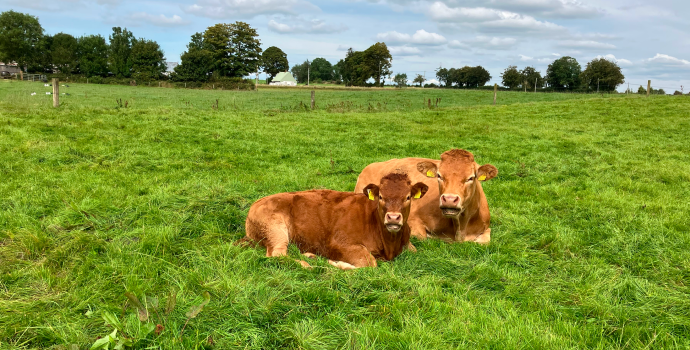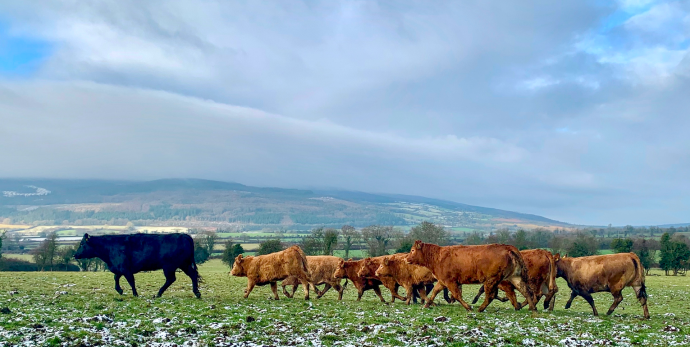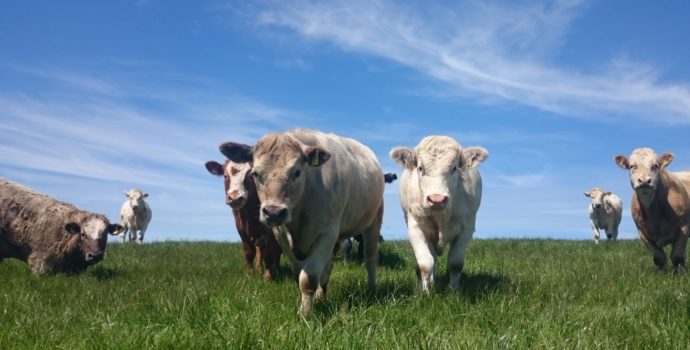Livestock Council Report September 2021

Market Report
- Beef Price: Steers are generally making €4.15 to €4.25/kg base price. Heifers are making €4.20 to €4.30/kg with higher deals for larger lots and increased breed bonuses paid. Young Bulls are ranging from €4.15 to €4.40/kg for R/U grades. Cows are making €3.60 to €4.00/kg.
- DAFM Reported Prices w/e 22/08/2021: R3 steer prices for the last week dropped by 5c/kg to €4.41/kg, R3 heifer prices dropped by 5c/kg to €4.44/kg. R3 young bull prices dropped by 7c to €4.22/kg. P+3 grade cows were back 2c/kg, O3 grades were back 1c/kg, R3 grades were up 1c/kg.
- Beef Market Tracking: The latest available data shows the Prime Irish Composite Price for to be at by €4.23 with the Export Benchmark Price at €4.06/kg
- GB Cattle Prices as reported by AHDB: Prices in GB for R3 steers increased slightly by 0.3p/kg in the latest week bringing the price to £4.15/kg
- The latest Commission reported R3 male cattle prices show Steers in Ireland excl. vat €3.99/kg, UK Steers €4.56/kg and EU Young Bulls at €3.78/kg.
- Latest DAFM Kill figures;
- Supplies: Supplies for the year to date are back 73,294 on the same period for 2020.
Supply Figures as Reported by DAFM – Week 33 (16.08.2021)
- Market Conditions: Market conditions are favorable for Irish beef. Good demand and stable to strengthening prices in our key export markets are underpinning the trade. The reduced volumes of South American imports in our key export markets have created positive market conditions for Irish beef exports as significant volumes of Brazilian beef in particular are being exported to China to meet the demand for protein in that country. Supplies are tight and will continue tight throughout the remainder of the year with Bord Bia predicting up to 40,000 less cattle available for slaughter compared to the same period in 2020, supplies to-date are back over 73,000. UK supplies are running 5% below last years levels and predictions are that these reduced levels of slaughter cattle will continue for the remainder of the year.
Live Exports
- For the week ending August 7th, live cattle exports reached 2,051 head.
- For the first 31 weeks of 2021, the number of animals exported is running 0.7% behind of the same period for 2020, with 198,518 head of cattle exported.
- The Irish calf exports YTD figure sits at 137,000 just behind the same period for 2020 but 27% behind the same period in 2019.
- 64,000 calves have been exported to Spain so far this year which is a 6% decrease on the same period for 2020.
- The movement of cattle to Northern Ireland has continued to perform strongly with almost a 25% increase on the 2020 figures.
- IFA have raised the issues with live exports to GB with the Minister for Agriculture and senior DAFM officials
CAP
Definitions
- There can be no differentiation between the proposed reintroduced 30% of previously ineligible land and productive land. Farmers must have the right to work the land as they see fit. Eg. Clear scrub, graze, use for Nitrates calculations etc.
- The inclusion of up to 30% of all land applied on by the applicant consisting of features that may be beneficial to water protection, climate or biodiversity should be impact assessed in the context of impact on the value of payments. The areas consisting of features that may be beneficial to water protection, climate or biodiversity will vary across all parcels and the max 30% per parcel could unfairly penalise some farmers. Allowing for up to 30% of all land applied on to be considered eligible simplifies the proposal provided there is no significant impact on payment levels or unintended distortion of the land market.
GAECS
- GAEC 4: To avoid loss of grazing land, shelter for animals and the imposition of significant cost on farmers buffer strips must not require fencing off.
GAEC 9:
- The minimum EU Regulatory requirement must be applied
BISS
- Convergence must be limited to 85% to protect the viability of beef and suckler farmers
CRISS
- The Committee acknowledge that while CRISS has been presented as being beneficial for 80% of beef and suckler farmers, the modelling by the department shows only a minor increase in payment for those who benefit and a major loss for those who will have payments reduced, who are primarily beef farmers.
Eco-schemes
- Eco-schemes cuts must be kept to a minimum. Eco-schemes monies are monies farmers currently receive without additional obligations, the amount of monies taken from farmers to establish the Eco-scheme budget must kept to a minimum recognising the already significant ‘green’ ambition within Ireland’s Pillar 2 programmes.
- Every farmer must be provided with the opportunity to claim back at a minimum all of the money taken from their entitlement value.
- Eco-schemes must be developed to support beef and suckler farmers producing food and reflect the higher costs and reduced efficiencies associated with this higher ambition that is imposed on them from the EU.
Suckler Carbon and Environment Measure
- The proposed suckler cow scheme requires a funding commitment annually to return €300/cow for participant farmers with an annual budget of €270m
- The current proposal lacks ambition to provide the opportunity for participants to generate €300/cow and must be amended through increased/updated costings and additional practical and beneficial measures for suckler farmers.
- The proposal to penalise farmers who increase suckler cow numbers, effectively capping and limiting the national suckler cow herd is not acceptable and must be removed.
- The compulsion to be part of the Bord Bia Quality Assurance Scheme as an eligibility requirement of the scheme must be removed. Quality Assurance is a market requirement which should be rewarded from the market place. It is not appropriate as a requirement for eligibility. Carbon is being measured through other schemes without the requirement to be a member of the QA scheme.
- Reference numbers in the scheme must ensure the level of activity on the farm is accurately captured and new entrants to the sector must be facilitated in building their reference numbers while participating in the scheme.
Cattle rearing and finishing scheme
- The IFA Submission on the Presentations given to the CAP Consultative Committee relating to the CSP sought an extension to the Pilot Dairy Calf to Beef Scheme to include meaningful payments to farmers who rear and finish weanlings and stores from suckler farms. These farmers must be provided with a scheme that returns at least €100 an animal in the Strategic Plans with a budget allocation of €100m annually.
Agri Environmental Scheme
- A targeted meaningful agri-environmental scheme that supports suckler and beef farmers must be provided in Pillar 2.
Mercosur
- IFA have highlighted the double standards applied by the commission in this trade deal compared to the standards demanded from Irish and EU beef farmers.
- IFA have called on the Irish Government to reject this deal.
- Irish beef farmers will be most impacted if this additional sub-standard beef is allowed onto the EU and UK marketplace.
- IFA are fighting a strong campaign at EU level to have the deal rejected.
- IFA have met the Commissioner for Agriculture and called for this deal to be stopped.
Chinese Market
- IFA have called on the Minister for Agriculture and Government to redouble their efforts to secure an immediate return of Irish beef to the Chinese market following the announcement that Ireland has fulfilled the criteria to attained official status from the OIE of negligible risk status for BSE.
BDGP
- IFA called for the cohort of farmers who participated throughout the scheme but did not qualify for payment last year to be provided with the opportunity to join the scheme for 2021.
BEAM
- A six-month extension to the scheme was granted to give farmers more time to meet the 5% reduction. This offered participants the option to choose the reference period 1st January to 31st December 2021. Applicants had from April to June to apply to avail of the extended period.
- However, if applicants met the reduction requirement by the end of June for the original reference period this was automatically accepted as compliance.
- IFA advised that all farmers in the scheme apply for the extension.
- DAFM have provided the following updated figures:
- 17,800 met the requirement and are now finished with the scheme
- 11,000 opted for the extension and still need to meet the reduction
- 3,600 face a penalty
- IFA have sought the recognition of a TB breakdown during the course of the reference period as Force Majeure and the 5% requirement be removed.
- DAFM committed to applying the same criteria as is applied in the Nitrates calculation for restricted herds but due to audit concerns are not prepared to provide this
- All TB restricted farms have their reduction target reduced proportionally to the period of restriction for the farm
- DAFM recognize TB as a Force Majeure, all farmers can make an application to DAFM to have their particular situation recognized
- IFA are pursuing a simplified system with clear parameters which maximize the opportunity for all restricted farms to be accepted as Force Majeure and have the 5% requirement removed.
- IFA have sought a reduction in the sanctions for participants who fall short of the 5% requirement but have recorded a reduction in their herd.
- IFA are meeting DAFM to address a number of issues in the scheme including;
- The claw-back of monies
- The option of using the better of the reference periods
- TB situation
- The overriding objective from DAFM must be to help farmers hold on to the monies received
| Animal | Number | Change prev. wk. | % of total | YTD | YTD Change |
| Y Bulls | 1,333 | ▼-171 | 4% | 87,957 | ▼-13,803 |
| Bull | 566 | ▼-73 | 2% | 17,352 | ▼-4,414 |
| Steer | 17,037 | ▲223 | 50% | 396,559 | ▼-13,609 |
| Cow | 6,201 | ▼-263 | 18% | 220,363 | ▼-3,818 |
| Heifer | 8,717 | ▲140 | 26% | 296,751 | ▼-31,913 |
| Veal-V | 28 | ▲21 | 0% | 20,653 | ▼-5,838 |
| Veal-Z | 19 | ▲12 | 0% | 1,114 | ▲101 |
| Total | 33,901 | ▼-111 | 100% | 1,040,749 | ▼-73,294 |



